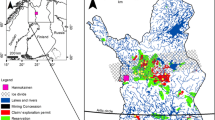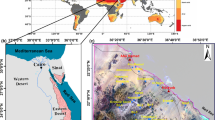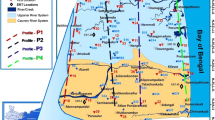Abstract
Typical of Mediterranean countries, the Lebanese shoreline is well known for its littoral and offshore groundwater discharges, the so-called submarine springs. The tectonic framework of the terrain explains its interruption by dense geologic structures, i.e., fracturing, faulting, karstic routes, as well as acute dips of rock strata seaward. All of these structures serve as hydrologic agents transporting groundwater to the sea. The study aims to locate these groundwater discharges, and to interpret their geologic controls on land. For this purpose, two major lines of approach were followed. The first is an airborne thermal infrared (TIR) survey using radiometers to identify thermal anomalies, thereby determining the exact location of submarine groundwater discharges (SGDs). The second line of approach is the analysis of satellite images (Landsat 7ETM+) to delineate the geologic features that govern the mechanism of water flow, thereby determining their sources on land. Twenty-seven major SGDs were identified, 10 of these being offshore springs, the others littoral springs. The springs show a large variety of discharge configurations and extents, mainly parallel or perpendicular to the shoreline or rounded. Three major structural controls were identified to contribute to the transport of groundwater to the sea. These are karstic galleries, faults, and tilted rock strata, their contributions being 48, 37, and 15%, respectively. The SGDs associated with linear passageways, i.e., karstic galleries and faults, are connected with land aquifer formations several kilometers away from the shoreline. Moreover, the presence of impervious rock formations at many localities along the coastline results in a confined hydrologic system, promoting the flow of SGDs into the sea.






Similar content being viewed by others
References
Abdallah M (1999) Annu Lab Rep Medical Laboratory of the South, Saida, Lebanon
Ahlbom K, Andersson J, Nordqvist R, Ljunggren C, Tiren S, Voss C (1991) Fjallveden study site. Scope of activities and main results. Stockholm, Svensk Karnbranslehantering Tech Rep 91-52
Ayoub G, Ghanam J, Khoury R, Acra A, Hamdar B (2000) The submarine springs in the Chekka bay, Lebanon: delineation of salient features. American University of Beirut & IDRC
Buddemeire R (1996) Groundwater discharge in the coastal zone. Proc Int Symp LOICZ/R&S/96-8.iv. LOICZ, Texel, The Netherlands
Burnett W (1999) Offshore springs and seeps are focus of working group. EOS 80:13–15
El-Qareh R (1966) The submarine springs of Chekka, exploitation of a confined aquifer discharging in the sea. MSc Thesis, Geology Department, American University of Beirut
FAO (1972) Project de développement hydro-agricole du Liban. Thermometric aéroportée par infrarouge. FAO, Beirut
Gorrell H (1958) Classification of formation waters based on sodium chloride content. Am Assoc Petrol Geol Bull 42:1990–2002
Gruvel A (1931) Les états de Syrie. Richesses marines et fluviatiles. Exploitation actuelle. Avenir, Paris
Jaber B (1995) Water problems of Lebanon (in Arabic). National Congress on Water, Strategic Studies Center, Beirut
Khawlie M (1995) Fault-controlled eastern Mediterranean coast, Lebanon: geological contribution to coastal management. Coastal Manage 23:41–55
Khawlie M, Shaban A, Abdallah C (2000) Evaluating the potentials of submarine springs: an unconventional water source for the coastal area—Lebanon. ESCWA Expert Group Meet, 14–17 November 2000, Beirut
Malkki E (2003) Groundwater flow conditions in the coastal bedrock area of the Gulf of Finland. Geol Q 47(3):299–306
NCRS (1999) TIR survey for fresh water resources on the marine environment along the coastal stretch of Lebanon. National Council for Scientific Research, National Center for Remote Sensing, Beirut
Reeves R, Anson A, Landen D (1975) Manual of remote sensing, 1st edn, 2 vol. American Society of Photogrammetry, Falls Church Publ, Virginia
SCOR/LOICZ (2000) Assessment and management implications of submarine groundwater discharge into the coastal zone. Proj Intergovernmental Oceanographic Commission, ICAM Program, Perth, Australia
Shaban A (2003) Studying the hydrogeology of occidental Lebanon: utilization of remote sensing. PhD Dissertation, Bordeaux 1 University
Shaban A, Khawlie M (1998) Geoenvironmental assessment through remote sensing of fresh water sources between Beirut and Anfeh coastal stretch (1972–1997). In: Proc 4th Int Conf Geology of the Middle East, 9–12 November 1998, ESCWA, Beirut, pp 181–189
Shaban A, Khawlie M, Abdallah C (2000) New water resources for southern Lebanon: thermal infrared remote sensing of submarine springs. In: Proc Conf South Lebanon Urban Challenge in the Era of Liberation, 3–6 April 2001, Beirut Arab University, pp 181–190
Shaban A, Khawlie M, Abdallah C (2004) Use of remote sensing and GIS to determine recharge potential zones: the case of occidental Lebanon. Hydrogeol J (in press)
Somma J, Gedeon B, Saliba-Badaro N (1998) Mise en relation du réseau de linéaments de surface avec les directions majeures d’écoulement souterrain dans un milieu karstique du Mont Liban à l’aide d’images HRV de SPOT et TM de Landsat. In: La réalité de terrain en télédétection: pratiques et méthodes. Rep AUPELF-UREF, Beirut, pp 289–294
Taniguchi M (2000) Evaluation of saltwater-groundwater interface from borehole temperature in a coastal region. Geophysics Res Lett 27(5):713–716
Todd K (1967) Groundwater hydrology. Wiley, New York
Author information
Authors and Affiliations
Corresponding author
Rights and permissions
About this article
Cite this article
Shaban, A., Khawlie, M., Abdallah, C. et al. Geologic controls of submarine groundwater discharge: application of remote sensing to north Lebanon. Environ Geol 47, 512–522 (2005). https://doi.org/10.1007/s00254-004-1172-3
Received:
Accepted:
Published:
Issue Date:
DOI: https://doi.org/10.1007/s00254-004-1172-3




